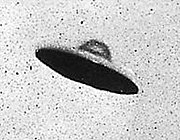This article needs additional citations for verification. (April 2020) |
Identifying unidentified flying objects (UFOs) is a difficult task due to the normally poor quality of the evidence provided by those who report sighting the unknown object.[1] Observations and subsequent reporting are often made by those untrained in astronomy, atmospheric phenomena, aeronautics, physics, and perception.[2] Nevertheless, most officially investigated UFO sightings, such as from the U.S. Air Force's Project Blue Book, have been identified as being due to honest misidentifications of natural phenomena, aircraft, or other prosaic explanations. In early U.S. Air Force attempts to explain UFO sightings, unexplained sightings routinely numbered over one in five reports. However, in early 1953, right after the CIA's Robertson Panel, percentages of unexplained sightings dropped precipitously, usually being only a few percent in any given year. When Project Blue Book closed down in 1970, only 6% of all cases were classified as being truly unidentified.
UFOs that can be explained are sometimes termed identified flying objects (IFOs).
- ^ Pasachoff, Jay M and Alex Filippenko (2004). The Cosmos: Astronomy in the New Millennium. Brooks/Cole div. of Thomson Learning. p. 428. ISBN 0-534-39550-3.
[O]bservations [of UFOs] are usually anecdotal, are not controlled in a scientific experiment, and are not accessible to study by sophisticated instruments.
- ^ Nickell, Joe; McGaha, James (2018). "UFO Identification Process". Skeptical Inquirer. 42 (6): 34–37. Archived from the original on 2018-12-23. Retrieved 23 December 2018.
© MMXXIII Rich X Search. We shall prevail. All rights reserved. Rich X Search

